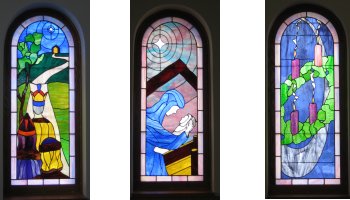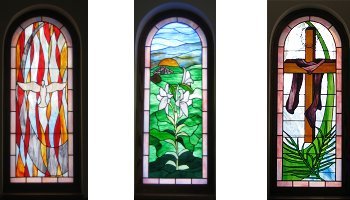- By Dan Veaner
- Around Town
 Print
Print  Early last December Lansing's All Saints Catholic Church got an early Christmas present when the first seven stained glass windows were installed. The windows were designed by local artist Tony Serviente and made and installed by Ithaca's Serviente Studios . "Like everything else that we approached we wanted to do things locally," says All Saints' Administrative Assistant Dave Lippert.
Early last December Lansing's All Saints Catholic Church got an early Christmas present when the first seven stained glass windows were installed. The windows were designed by local artist Tony Serviente and made and installed by Ithaca's Serviente Studios . "Like everything else that we approached we wanted to do things locally," says All Saints' Administrative Assistant Dave Lippert.Many of the church's elements are locally made. Lansing wood carver Bob Nagle made the statue of the Risen Christ above the alter. A mosaic baptismal font was made by Ithaca artist Linda Blossom. The alter, the ambo and the presider's chair was made by and Brooktondale's Elizabeth Wolf, and designed by Ithacan Mary McTiernan. Ithacan Bill Bakerturning made walnut candlesticks and an ambry. The window frames were made by Steve Peck of Trumansburg, who is known locally as 'The Wood Doctor.'
In the planning phase the congregation set on two themes for their 14 windows. The first would be 'The Liturgical Seasons of the Year.' The seven windows would represent the Advent season, the Christmas season, and the Epiphany season, as well as Lent, Easter, the Pentecost, and one for the ordinary Sundays of the year. The second theme would be 'The Seven Sacraments.' After that there is the possibility that two enormous triangle-shaped windows at each end of the sanctuary may be treated in stained glass.
Serviente worked with a committee from the church, with Peck, and with the architect for more than a year before the final installation. Church officials wanted a uniformity of design that is provided by a design element that Lippert calls a 'swish,' as well as the oak frame design.

Epiphany, Christmas, Advent
Aside from thematic and artistic concerns, church officials wanted to let natural light into the building. With two huge windows at each end of the church and a clerestory along the sides, they also felt it was important for the stained glass windows to admit light into the sanctuary. "Because of the way they are put in we don't lose a lot of light," Lippert notes. "Here we are in the darkest time of the year and it's not keeping outside light out. And the windows all have a lot of light in the design."
With a mortgage and a bridge loan, the church decided to only purchase the seven windows planned for the first theme for now. Because the window frames were constructed so that they could be inserted into any of the 14 window spaces, the first seven were placed in every other window for now. When it is possible to add the seven windows from the second theme, they plan to move the first batch to one side, so that each side of the church reflects all the images from one theme.
Serviente worked with a committee of church people who had specific ideas about what they wanted. "I enjoyed it tremendously," he says. "It was a very interactive group, and they're nice people. It wasn't as if they took everything I said and nodded and said, 'Well, you're the artist.' Some folks said, 'This is too literal,' or 'This isn't literal enough.' I got a lot of very specific requests for changes, but it was all done with great good humor and in a way that made me feel they valued my contribution to the project.'"
He designed the windows on a Computer Aided Design (CAD) program, which made it easy to quickly make changes requested by the committee. Lippert says that committee members also enjoyed working with Serviente. "One, he did excellent work," he says. "Two, he was extremely easy to work with. He brings with him a sensitivity to the environment that he's going to work in. It's not just a job -- it's a work of love for him."

Pentacost, Easter, Lent
Serviente echoes that sentiment. "I have to like the windows that leave my studio, and preferably love them," he says. "But it's really my client whose opinion is most important, because they're the ones that are going to be living with these things."
The $1.7 million 400-seat church was finished enough to hold services in last summer, and the official dedication was at the end of last September. It is the third church the congregation has built since 1913. Lippert says the building helps draw new congregants as well as providing ample space for current church members. And he says the response from the congregation at large has been very positive, and that having stained glass makes it feel more 'church-like.' "The response has been, 'Ooh. Ah! They're beautiful!' People just stare at them."
Having so many elements of the church locally made has a spiritual bonus as well. "If you can design a building that brings the creation that exists in the area you are in," Lipperst says, "and can bring it from the outside into the inside, and have the work reflect the people of the area -- we're not apart from, we're a part of this grand creation -- I think it's important to do that."
----
v4i3



